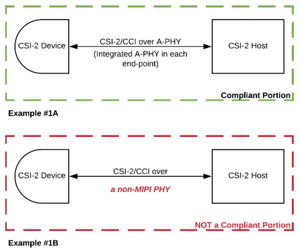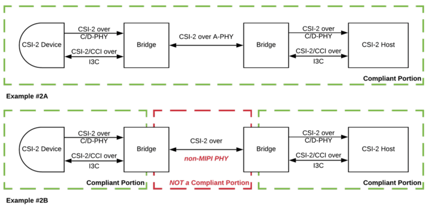5 min read
Protocols, PHYs and the MIPI Alliance IPR Terms
![]() Brad Biddle, MIPI Counsel
:
9 January 2020
Brad Biddle, MIPI Counsel
:
9 January 2020

- News & Events
- News
- Blog
MIPI Alliance periodically receives questions about how its legal policies apply in different circumstances. This post addresses questions we’ve received about the requirement that MIPI protocols be used only with MIPI PHYs. The post explains existing policy. It does not change any current MIPI Alliance legal terms.
MIPI specifies that MIPI protocols be used on MIPI PHYs
From MIPI Alliance's inception, the Alliance has specified that MIPI-defined protocols must run over MIPI-defined PHYs. The current versions of MIPI CSI-2SM and DSI-2SM, for example, each explicitly require that they be used with either MIPI C-PHYSM or D-PHYSM. MIPI Alliance anticipates that future versions of these and other protocol specifications will continue to reference the current MIPI PHY specifications, because MIPI protocols and PHYs are optimized to work together.
A non-MIPI PHY is not a "Compliant Portion"
MIPI Alliance’s intellectual property rights (IPR)-related terms include a key concept: "Compliant Portion." The precise definition is set out in the MIPI membership agreement, but the essence is that Compliant Portions are those specific portions of products (hardware, software, or combinations of the two) that implement and are compliant with the relevant portions of a MIPI specification. Because MIPI explicitly specifies that MIPI protocols must run over MIPI PHYs, a portion of a product that uses a MIPI protocol over a non-MIPI PHY can never be a Compliant Portion.
Qualifying—or not qualifying—as a Compliant Portion has important legal consequences
If a MIPI member’s product or product component is a Compliant Portion, then: (1) the member and its customers benefit from MIPI Alliance’s royalty-free patent licensing obligation, (2) the member is permitted to disclose elements of the applicable MIPI specifications to suppliers and customers, subject to certain limitations, and (3) the member can use certain MIPI Alliance trademarks in connection with its product distribution. Conversely, if a product or component is not a Compliant Portion, then the member does not have these rights. Each of these areas will be discussed in more detail below.
Examples of Compliant Portions, including with "bridges"
Some examples can illustrate how the concept of Compliant Portion can apply in different implementation configurations. These examples use MIPI camera protocol specifications (CSI-2 and CCI) and the upcoming MIPI A-PHY℠ specification for purposes of illustration, as we’ve received questions about this anticipated future scenario in particular, though the concepts apply more broadly.

Example #1: Direct connection
A product that directly connects a device and host using a MIPI protocol and MIPI PHY as specified in the applicable MIPI specifications can be a Compliant Portion (Example 1A).
Conversely, a product that uses a non-MIPI PHY with a MIPI protocol would not be a Compliant Portion (Example 1B).
Example #2: Bridge
Another potential configuration involves so-called "bridge" chips.
 One scenario, pictured in the diagram labeled Example 2A, involves the use of bridge chips with MIPI protocols traveling only over MIPI PHYs. In this case, all elements of the product implementing the MIPI specifications could be Compliant Portions.
One scenario, pictured in the diagram labeled Example 2A, involves the use of bridge chips with MIPI protocols traveling only over MIPI PHYs. In this case, all elements of the product implementing the MIPI specifications could be Compliant Portions.
Another scenario, pictured in the diagram labeled Example 2B, shows MIPI protocols traveling over a non-MIPI PHY. In this case, the portion of the product that implements the non-MIPI PHY would not be a Compliant Portion. However, the product or product components from a MIPI member that included only a compliant implementation of the applicable MIPI specifications (e.g., a product that connected a CSI-2 device to a bridge chip using a MIPI PHY) could be a Compliant Portion.
Implications for third-party specification development efforts
The questions that sparked this blog post arose most acutely in connection with third-party efforts that envision using MIPI protocols over non-MIPI PHYs. To be clear: Use of MIPI specifications in specification development outside of MIPI requires explicit authorization from MIPI Alliance. Key legal points to understand in connection with this idea include:
- No patent licenses
MIPI Alliance’s IPR terms require that MIPI members grant other MIPI members a royalty-free patent license in connection with essential patent claims that apply to Compliant Portions. This obligation applies only to Compliant Portions. A product component that implemented a third-party specification that defined use of a MIPI protocol over a non-MIPI PHY would not be a Compliant Portion. An essential claim owner could thus demand potentially unlimited royalties or seek injunctions on shipping products.
- No disclosure or distribution of MIPI specifications
Most MIPI specifications are confidential and available only to members. Under MIPI Alliance’s membership agreement, members are permitted to disclose MIPI confidential specifications to certain third parties such as suppliers or customers in limited circumstances, but in all cases disclosure and distribution is only permitted in connection with the production and sale of Compliant Portions. Disclosing any portion of a MIPI specification for a purpose other than for the creation or sale of a Compliant Portion—such as for the purpose of creating a third-party specification that facilitated use of a MIPI protocol specification over a non-MIPI PHY—would violate the non-disclosure and copyright terms of the MIPI membership agreement and be a misappropriation of the Alliance’s confidential information.
- No trademark use of MIPI specification names
The MIPI Alliance membership agreement grants a limited trademark license to use MIPI trademarks, including specification names such as CSI-2 and DSI-2, only in connection with Compliant Portions. Using these marks in connection with other implementations could be trademark infringement.
MIPI can and does authorize third-party use of its specifications
MIPI Alliance has a long history of cooperative liaison arrangements with other organizations. If the Alliance determines that use of a MIPI protocol over a non-MIPI PHY is technically equivalent or superior to implementations that couple MIPI protocols and PHYs, and that such use would benefit the MIPI membership and other industry stakeholders, the Alliance could specify this approach as compliant, thus making implementations Compliant Portions.
Unless and until the MIPI Alliance Board of Directors explicitly authorizes uses of its specifications in this manner, however, use of MIPI specifications in connection with third-party specification development efforts is unauthorized and raises the problematic legal issues described in this post.
MIPI acknowledges alternative third-party specification development efforts
MIPI Alliance recognizes that industry participants may desire to create specifications outside of the Alliance. Parties may have a good faith technical disagreement with MIPI’s direction, for example, or may wish to develop specifications in a "RAND" (reasonable and non-discriminatory) IPR environment, in contrast to the Alliance’s royalty-free structure, so that the specification developers can collect patent royalty payments from implementers. MIPI Alliance insists that its own intellectual property rights be respected in connection with such efforts, however. Third-party specification development efforts should not use MIPI intellectual property except as authorized.
Summary
- MIPI Alliance specifications define what qualifies as a "Compliant Portion" under the MIPI IPR terms, and using MIPI protocols over a non-MIPI PHY does not qualify because MIPI's protocol specifications require that these protocols be used over MIPI PHYs.
- An implementer of a third-party specification that facilitated use of a MIPI protocol over a non-MIPI PHY, as well as its customers, would thus face patent risks, because they would not benefit from the MIPI royalty-free patent license terms.
- The implementer would also not be licensed to use MIPI trademarks.
- A MIPI member who disclosed or distributed any portion of a MIPI specification in order to create this kind of third-party specification would be breaching MIPI Alliance’s confidentiality and copyright terms.
- Non-members have no right to access or use confidential MIPI Alliance specifications, unless explicitly authorized by the MIPI Board of Directors.
- MIPI Alliance can and does authorize third-party use of its specifications, and could define a specific use as compliant, but will do so only if it is in the best interest of its members.
Questions about this blog post can be directed to MIPI Managing Director Peter Lefkin and MIPI counsel Brad Biddle. This post describes important principles underlying the MIPI IPR terms, and provides illustrative examples, but does not comprehensively describe the terms or provide exhaustive examples. Readers should read the IPR terms and consult with their own counsel about how the terms apply to their own particular circumstances.
Brad Biddle serves as outside general counsel to MIPI Alliance, among other activities. He is co-editor of the book, Patent Remedies and Complex Products, published by Cambridge University Press, which was awarded "Best Patent Law Book of 2019."






